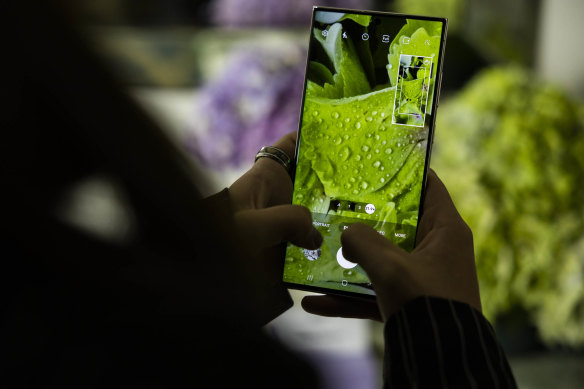
But that’s only one of the four cameras on the back of the phone. What about the others, which are hardware-wise the same as last year’s S22 Ultra, and that purported 100x zoom?
The bottom-most shooter is a 10MP, 230 millimetre telescope camera, meaning it sits vertically inside the body of the phone using an angled mirror to see out, and produces a native 10x optical zoom. If you keep zooming beyond that point, the phone will essentially be taking a crop of that image, and after you hit the shutter it will use AI and a lot of sharpening in an attempt to produce an intelligible picture, which is tough at 30x and even harder at the maximum 100x.

The ultra-wide camera and range of zoom lenses makes the Ultra great for very close or very far subjects.
To be honest, it’s hard to think of use cases for a 100x smartphone zoom apart from taking pictures of the moon and spying on your neighbours, and it isn’t that good at either. The image stabilisation cleverly latches on to what it thinks is the subject, or any object you tap on, so you can get results without a tripod. But you won’t see a clear image until after the shot is processed, if at all, and even in ideal lighting you get a lot of wobbly artefacts as the phone tries to remove noise and take a guess at where to create detail and texture. Having that 10x lens as a starting point means you’ll get better 15x or 20x crops than other phones, but they generally aren’t pretty.
To one side of the camera stack is another 10MP telephoto camera, this one at 3x zoom. Given enough light, you can get really impressive results at both 3x and 10x, which gives you a bit more flexibility over the fanciest iPhone (3x only) or Pixel (5x only).
I was also very impressed with the S23 for macro photography. Where the latest iPhones really struggle to hold a focus up close, the Ultra easily produced a clear image only two or three centimetres away. Which is thanks to the fourth camera, an ultra-wide. Of course, doing that with enough light is tricky, but I also got great results at 3x zoom from around 6 centimetres away, and 10x zoom from around 20 centimetres, great for details on small things like bugs.
Loading
The S23 Ultra gives a fantastic photography experience overall, and I’m reasonably confident in saying its camera performance is superior to its rivals. But I’m not sure that’s the best question to be asking, especially since the phone is significantly more expensive, and the difference is small enough that it’s likely to be outweighed by other considerations; you might like iOS better as an operating system for example, or be very keen on the Pixel’s design or much lower cost. The Ultra has unique benefits of its own besides the camera too, like its very satisfying stylus.
We’ve reached a place in smartphone photography where there are almost no wrong choices. I’ve taken very good pictures on $400 phones, and for most people who take photos for keepsakes, to post online or send to people (i.e. not people doing extensive manual post-editing or professional photo work), the result isn’t all that different.
I’d also argue the true frontier for smartphone photography is more in the computational tasks than in the hardware, for applications such as blurred backgrounds, low-light shots and astrophotography, where all three of the major brands are very competitive in their high-end phones.
Get news and reviews on technology, gadgets and gaming in our Technology newsletter every Friday. Sign up here.



























